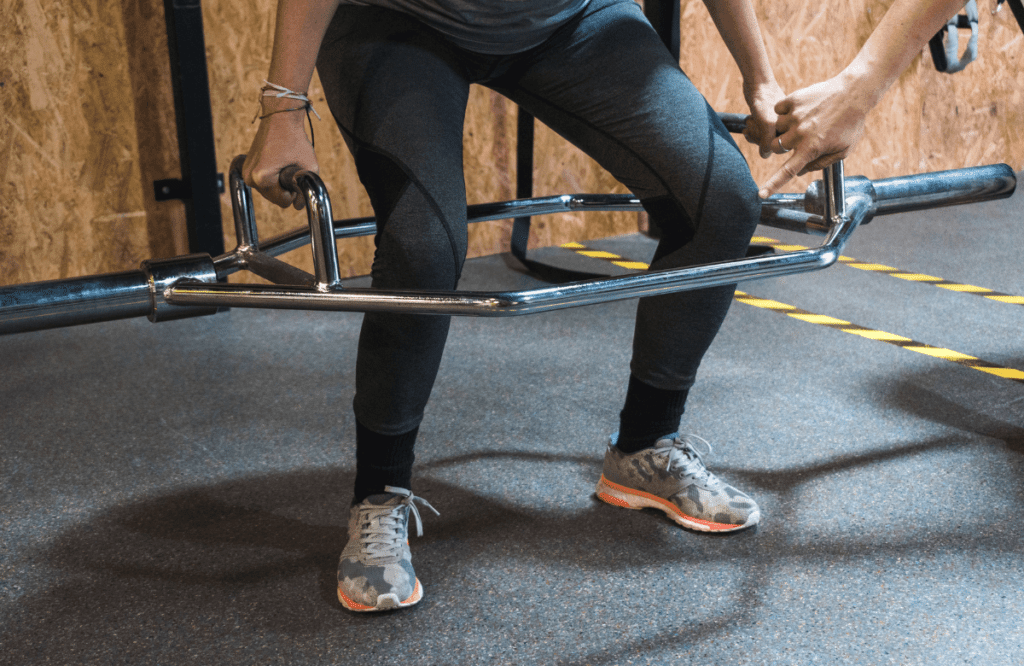The hex bar vs. barbell deadlift debate isn’t over just yet. The deadlift is one of the oldest strength tests available and is the gold standard for competitions. But the hex bar has gained popularity, controversy, and a cult-like following since its invention in the mid-’80s.
So, which one is right for you? Can you lift more on the conventional deadlift or hex bar? Let’s look at the answers to these questions, the differences, advantages, and best-use cases for each exercise.
Jump to:
What’s a Hex Bar or Trap Bar?
The hex bar is a weightlifting barbell with a 6-sided hexagon design invented by competitive powerlifter Al Gerard. It’s sometimes called the trap bar because it was designed to train the trapezius muscles. However, it can be used for several exercises like the deadlift, overhead presses, and upright rows.
The 6-sided shape is typically made from steel welded together and weighs between 45-60 lbs, depending on the model. Most models have a completely closed design that requires you to stand in the center to execute lifts. Many configurations have raised handles for increased grip.
Hex Bar Deadlift Advantages
- Easy to use for beginners.
- Less stress on the lower back.
- You can lift heavier loads.
- Doesn’t scrape the shins like a standard barbell.
- Easier to maintain grip strength during heavy lifts.
- The compound exercise targets the quads more than traditional deadlifts.
- Sets of handles for easy use.
Hex Bar Deadlift Disadvantages
- Doesn’t activate the hamstrings, glutes, biceps, or back as much as a standard barbell deadlift
- The hex bar has very little flex or bend
- A shorter range of motion leads to less complete muscle activation
- Doesn’t offer as much deadlift variation as a standard barbell
- You can’t control the grip width making it less suited for specific heights and body types.
- Can’t perform sumo deadlift

What’s a Straight Barbell Deadlift?
You’re most likely familiar with the straight barbell, as it’s a common exercise tool used in weight training, bodybuilding, weight lifting, powerlifting, and other sports.
The barbell length varies between 4 ft to 8 ft, although bars longer than 7.2 ft aren’t typical and are used chiefly by powerlifters. Many barbells are engraved with knurled crosshatch patterns to provide more friction and better grip.
The full-size barbell used for deadlifts will weigh between 44-45 lbs, but you can find smaller models that weigh as little as 15 lbs. Most constructions are made of steel.
Straight Barbell Deadlift Advantages
- Activates the hamstrings, glutes, and back more than the trap bar
- Increased posterior chain training
- It can suit any grip width or stance
- Strength translates to Olympic barbell movements like the snatch or clean and jerk
- It’s the standard for weightlifting competitions
Straight Barbell Deadlift Disadvantages
- Harder to learn than the trap bar
- Barbell deadlifts place more pressure on the lower back and spine
- You may need accessories like lifting straps, chalk, or hooks to reach your full potential
- Different grip techniques can cause muscle imbalances or injuries
- Can’t lift heavy weights

The Differences Between Hex Bar and Barbell Deadlift
Although they might seem similar, the hex bar and barbell deadlift have significant differences, benefits, and best-use cases. Factors like technique, body mechanics, muscle activation, and load options change depending on the movement. Let’s take a deeper look at the differences between the two exercises.
Grip Position
The grip position is one of the primary differences between the hex bar deadlift and the conventional barbell deadlift.
- The hex bar provides a neutral grip, as the hands are at your sides, with the palms facing you. This may reduce the risk of shoulder injury or strain, as you have a neutral grip and the shoulders are externally rotated
- The hexagonal barbell may protect your biceps from tears, as the neutral grip technique places less pressure on the biceps compared to an overhand or mixed grip. Bicep tears are uncommon when performing a barbell deadlift, but they can happen
- The barbell deadlift activates the biceps more than the trap bar, which can be beneficial if you seek a higher compound movement
- The barbell deadlift offers more grip variation, like overhand, mixed, and hook techniques. That said, the mixed grip may cause muscle imbalances, while the hook grip can be uncomfortable for inexperienced lifters
- The barbell deadlift might require additional accessories, like lifting straps, chalk, or hooks. These tools aren’t necessarily a downside but can be inconvenient if you’re looking for an easy-lifting solution
Body Position
The body mechanics between the hex bar and barbell deadlift are significantly different and will change how you perform the exercise.
- The hex bar puts less stress on the back to stabilize the body, as it places the weight around your center of gravity
- The movement path is restricted with traditional barbell deadlifts. The bar must touch your shins and thighs, so you have to keep a forward-bent posture
- The upright position of the trap bar places more load on the knees instead of the hip joint and lower back. This weight distribution may ben’t ideal for those with bad knees
- The barbell deadlift form can be more challenging to learn and master. Trap bar deadlifts might be better suited for novice lifters

Muscle Activation
Because the body mechanics are different, the muscles activated between the two lifts also change.
- Both exercises target similar muscles in the posterior chain, like the hamstrings, glutes, and low back. The difference is the level of activation
- The conventional barbell deadlift has a greater focus on the hamstrings and glutes. The movement requires the body to rotate around the hips using the posterior chain
- Hex bar deadlifts require more rotation around the knee joints, requiring more effort from the quads. The trap bar variation places less emphasis on the posterior chain muscles
Load Options
The weight you can lift between the trap bar and barbell deadlift will also be significantly different.
Various studies have found that lifters can pull around 15% more with the hex bar deadlift than traditional deadlifts. This difference could mean pulling around 350 lbs with the trap bar and 305 lbs on the conventional barbell.
The same study also found that peak power, peak velocity, and force increased with the high-handle trap bar deadlift. That said, the long-term effects of the reduced range of motion of the trap bar deadlift are yet to be discovered.

Which Should You Program?
As you can see, there are significant differences between the hex bar and barbell deadlift. But which movement should you add to your routine? It would be easy to say, “It comes down to personal preference,” which is true—but that answer won’t provide you with the information to make an informed decision.
Although there isn’t a universal rule for designing a training program, you can use research-backed advice to determine the best steps forward. Let’s take a deeper look at some main factors when deciding between the trap bar and a conventional deadlift.
Beginners
As a beginner, you’ll start slowly, but you might notice explosive gains in as little as three months with the right program. Beginners must prioritize the correct technique and body control when learning compound movements like the deadlift.
Starting with barbell deadlifts might be easier, more accessible, and prepare you for competitions if that’s your goal. That said, the trap bar deadlift may help you learn the hip hinge pattern more effectively. The trap bar has a decreased range of motion and places less pressure on the lumbar spine, making it easier for beginners.
That said, your body mechanics, learning method, fitness level, and goals will vary. It’s best to take time, practice technique, and determine what suits your body.
Strength Training
As mentioned earlier, studies have found that athletes could lift upwards of 15% more weight with the trap bar. The peak force, peak power, and peak velocity levels were higher with the trap bar deadlift than with the straight bar deadlifts.
With this in mind, you might gain more raw strength using the hex bar deadlift instead of the standard barbell.
Depending on your goals, you might make the trap bar deadlift your primary variation or schedule it into your program throughout the week. This will also vary if you want to compete in powerlifting or Olympic events.
Sports and Athletics
Powerlifters and competitive weightlifters should prioritize the barbell deadlift, as it’s the standard for competition settings. Mastering your technique, strength, and body control on the conventional deadlift will pay off in competitive arenas.
Many competitive lifters include variations in their programming, like trap bar deadlifts, Romanian deadlifts, and more.
Other athletes, like football or basketball players, might want to opt for the hexagonal bar deadlift. The hexagonal design allows you to lift more weight and develop more force, velocity, and power, making it ideal for various sports.

Rehabilitation or Injury
The trap bar deadlift might be the better choice for rehabilitation as it places less stress on the low back than conventional deadlifts. If you experience low back pain, opt for the trap bar.
Lifters with knee injuries might want to stick with the barbell deadlift, as the trap bar requires more power from the knees.
All that being said, be sure to talk to your primary care physician before making any decisions if you have any injuries or sprains. Your doctor can help you determine which movements will help or exacerbate painful symptoms.
Frequently Asked Questions (FAQ)
Is Deadlifting With a Hex Bar Easier?
The hex bar deadlift can be easier for some lifters, as the weight is kept toward their center of gravity as they execute the movement. The hex bar variation can also place less pressure on the lower back and biceps compared to the traditional barbell deadlift. Additionally, many lifters find the hex bar easier to learn than the straight barbell deadlift.
Why Can I Lift More With a Hex Bar?
One study found that powerlifters had a 15% increase in their 1 RPM when using the hex bar for the deadlift. The hexagonal barbell deadlift provides a shorter range of motion, places the weight in your center of gravity, and has a neutral grip. These factors help you lift more weight compared to the standard deadlift.
Is the Barbell Deadlift Better Than the Hex Bar?
The answer mostly comes down to personal preference, body type, and fitness goals. Studies have found that lifters can move more weight with the hex bar and have increased peak power, force, and velocity. That said, the trap bar variation emphasizes the hamstrings less than the barbell deadlift.















